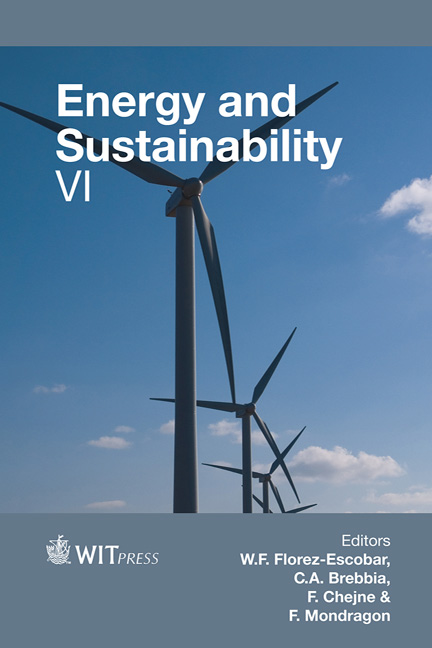Waste-valorisation By Municipal Solid Waste Carbon Use In A Chinese Township
Price
Free (open access)
Transaction
Volume
195
Pages
11
Page Range
523 - 533
Published
2015
Size
611 kb
Paper DOI
10.2495/ESUS150441
Copyright
WIT Press
Author(s)
S. Petters, K. Mauthner, K. Tse
Abstract
A small heavy industry town, severely affected by recent coal-use limitations by central government decided to re-invent itself into a “model-town”, following China’s new parole of “carbon efficiency”. Currently, 250t of municipal solid waste [MSW] are landfill disposed, evenly spread and covered with soil every day. Moisture content of the MSW is 45% and the calorific value is 9.5GJ/t. o addWe proposed gross separation into bio-chemical and thermo-chemical processing fractions through coarse and drum sorting into fermentable sludge and combustible solid fuel. Anaerobic digestion [AD] residue of ~30% of input mass is mechanically dewatered for co-processing with the solid fuel fractions in a fast internal circulating dual fluidized bed reactor [FICDFB].
The FICDFB decomposes feedstock into energy-rich gases under anoxic atmosphere of a bubbling, steam fluidized bed and can fuel itself from unconverted char, mixing with the bed-material, looping between the two reactor chambers as heat transfer medium, as long as the compounded average calorific value of total feedstock is ≥ 10GJ/t. Due to the AD step, solid fuel fractions and digestate compound to ~17GJ/t feedstock, thus allowing one to further add stabilized sewage sludge at ~27% of per capita waste aggregation, bringing the calorific value down to ~11GJ/t again.
The combined treatments’ output from the total chemical energy content of MSW and sewage sludge, representing 37MWchem per hour is 70% “burner-gas” and 22% “heat”, whereof ⅕ qualifies as exergy. So total exergy-yield is ~75%.
Since 60% of the gas’ energy is represented by typical chemical synthesis gas moieties (hydrogen [H2] + carbon monoxide [CO]) we further designed thermo catalytic dissociation [TCD] of the methane [CH4] yields in, representing 40% energy, co-producing hydrogen and carbon-12 powder, which can directly be used for CO2 splitting into further 2CO per molecule, delivering 100% synthesis gas of 1.8 H2: 1 CO for any gas to liquid synthesis. Consequently the MSW plant can produce RMB 700–1,500 revenue from each ton’s MSW ambient carbon reuse-ratio of ~60% and create new employment.
Keywords
2°C carbon budget, ambient carbon re-uses, atmospheric carbon stock, carbon capture for use, carbon efficiency, CO2-neutral, CO2-recycling, chemical synthesis chemicals, fossil substitutes, hydrocarbon transformation





